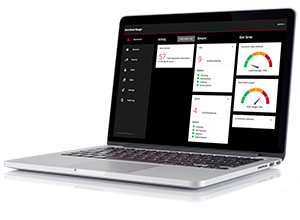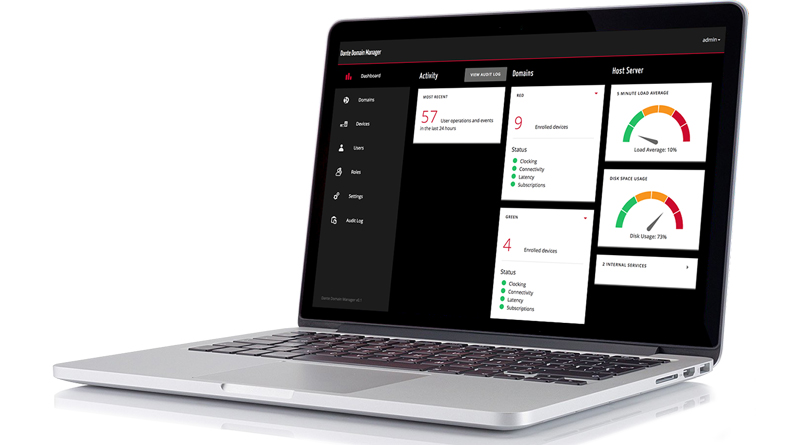Considering Networked AV During Design and Pre-Construction
By Bernie Farkus
As with any successful construction project — be it a single structure or a brand-new campus — a tremendous amount of planning goes into design. Fortunately, advances in networked audio-video (AV) products allow for the implementation of sophisticated, connected systems at a cost that was not even imaginable a decade ago.
One of the first things to consider for a new campus is the additional infrastructure required for networked AV systems. Will the AV equipment require a dedicated network separate from the rest of the facility? Is it capable of running on a converged network, alongside the rest of the data traffic on the campus network? Or is the answer somewhere in between? Whichever method, planning for additional raceways, conduit, wall and floor boxes, and other cabling requirements that are above and beyond the enterprise network infrastructure is necessary.

Photo Credit: Audinate
In addition to the physical location and space required for AV equipment (be it free standing or wall-mounted equipment racks, instructor desks/lecterns, monitors, projectors, etc.) AC power requirements for these devices and sub-systems must be considered. This is another area in which the benefits of a networked AV approach become apparent. This approach provides increased flexibility in the physical location and powering for many of these devices. The ability to centrally locate devices such as media servers, audio DSPs, and control system processors — and have them connect to the network “edge” devices (I/O wall plates, video displays, amplifiers/powered loudspeakers, etc.) throughout the building or campus — is key.
When considering a networked AV design, some in-depth research is recommended. Do not assume that every AV device that has an RJ45 (registered jack) network connector can exist on a converged network with other devices. Learn as much as possible about the network protocols being used. Is it a proprietary protocol that locks your system into only using one or a few manufacturers? Or is it a protocol that is used by hundreds of manufacturers, which offers freedom of choice? Make sure the products under review do not require special or dedicated network switches. And if the products under consideration do require their own separate, dedicated media network, make sure to adjust cabling infrastructure and AV budget accordingly.
One of the most overlooked benefits of networked AV is that the network becomes a distribution system. Audio and/or video sources from one device or system can easily be made available to others on the network. To achieve this signal routing flexibility campus wide, it’s necessary to understand the bandwidth utilization for each AV system. This requires research into the types of signals (video, audio, control, digital signage, etc.) and the respective standards and networking protocol being used (e.g., the resolution used for video: HD, 4K, etc.). This information is typically available online from manufacturers.
After studying the bandwidth, look at the desired distribution of the signals under a variety of different situations. Let’s use the example of a media production center. The center is located in a building with several studios that are used daily to record classes from various lecture halls across campus (several channels of audio and HD video per classroom). These studios are also used for multi-track audio and video recording of bands, a full orchestra and choir concerts from the performing arts center (possibly hundreds of audio channels and HD/4K video). Knowing how the systems are to be used in a variety of situations, and the associated bandwidth requirements will allow users and network designers/consultants/IT department professionals to provide proper design that will serve will for years to come.
Networked AV should be used in every campus design. Doing so provides:
- Reduced cost
- Leveraging a common network infrastructure
- Unrestrained distances
- Once audio and video are on the network it can be easily sent anywhere in the building or campus
- Using fiber interconnectivity for private Wide Area Networks for low latency applications
- Connect to the Internet and now it has access to the world
- Once audio and video are on the network it can be easily sent anywhere in the building or campus
- Limitless creation and consumption points
- Any network jack can become a signal ingestion, distribution, and control center
- Architectural flexibility
- Being able to free up valuable floor space by centralizing devices
- Utilizing the network for distribution of AV content
- Locating other devices at the creation and/or consumption points
- Using Power over Ethernet (PoE), which is available on many networked AV products to remotely power said devices
- Being able to free up valuable floor space by centralizing devices
Making sure an institution has a proper network infrastructure, one that meets present-day uses and allows for easy upgrades and future expandability, begins with planning. And there is no better time to begin planning than now.
Bernie Farkus is a senior technical sales engineer at Audinate.

